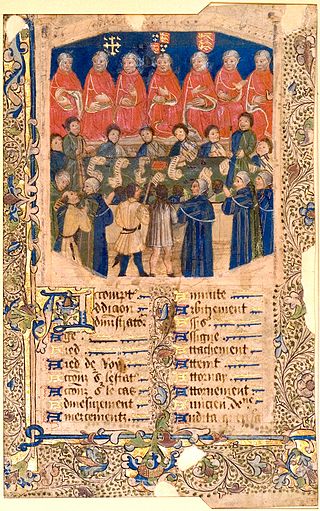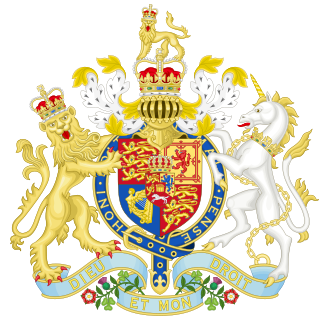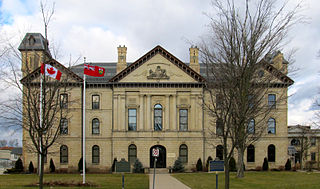
The Supreme Court of Judicature Act 1873 was an Act of the Parliament of the United Kingdom in 1873. It reorganised the English court system to establish the High Court and the Court of Appeal, and also originally provided for the abolition of the judicial functions of the House of Lords with respect to England. It would have retained those functions in relation to Scotland and Ireland for the time being. However, the Gladstone Liberal government fell in 1874 before the act entered into force, and the succeeding Disraeli Conservative government suspended the entry into force of the act by means of the Supreme Court of Judicature (Commencement) Act 1874 and the Supreme Court of Judicature Act 1875.
The Courts of England and Wales, supported administratively by His Majesty's Courts and Tribunals Service, are the civil and criminal courts responsible for the administration of justice in England and Wales.

In the history of the courts of England and Wales, the Judicature Acts were a series of acts of Parliament, beginning in the 1870s, which aimed to fuse the hitherto split system of courts of England and Wales. The first two acts were the Supreme Court of Judicature Act 1873 and the Supreme Court of Judicature Act 1875, with a further series of amending acts.

The Courts Act 1971 is an act of the Parliament of the United Kingdom, the purpose of which was to reform and modernise the courts system of England and Wales, as well as effectively separating the business of the criminal and civil courts.
A prothonotary is the "principal clerk of a court," from L.L. prothonotarius, from Greek protonotarios "first scribe," originally the chief of the college of recorders of the court of the Byzantine Empire, from Greek πρῶτοςprotos "first" + Latin notarius ("notary"); the h appeared in Medieval Latin. The title was awarded to certain high-ranking notaries, and was first recorded in the English language in 1447.

The County Palatine of Durham was a jurisdiction in the North of England, within which the bishop of Durham had rights usually exclusive to the monarch. It developed from the Liberty of Durham, which emerged in the Anglo-Saxon period. The gradual acquisition of powers by the bishops led to Durham being recognised as a palatinate by the late thirteenth century, one of several such counties in England during the Middle Ages. The county palatine had its own government and institutions, which broadly mirrored those of the monarch and included several judicial courts. From the sixteenth century the palatine rights of the bishops were gradually reduced, and were finally abolished in 1836. The last palatine institution to survive was the court of chancery, which was abolished in 1972.

The Court of Common Pleas, or Common Bench, was a common law court in the English legal system that covered "common pleas"; actions between subject and subject, which did not concern the king. Created in the late 12th to early 13th century after splitting from the Exchequer of Pleas, the Common Pleas served as one of the central English courts for around 600 years. Authorised by Magna Carta to sit in a fixed location, the Common Pleas sat in Westminster Hall for its entire existence, joined by the Exchequer of Pleas and Court of King's Bench.
The Court of Chancery of the County Palatine of Lancaster was a court of chancery that exercised jurisdiction within the County Palatine of Lancaster until it was merged with the High Court and abolished in 1972.

The Chancery Amendment Act 1858 also known as Lord Cairns' Act after Sir Hugh Cairns, was an Act of the Parliament of the United Kingdom that allowed the English Court of Chancery, the Irish Chancery and the Chancery Court of the County Palatine of Lancaster to award damages, in addition to their previous function of awarding injunctions and specific performance. The Act also made several procedural changes to the Chancery courts, most notably allowing them to call a jury, and allowed the Lord Chancellor to amend the practice regulations of the courts. By allowing the Chancery courts to award damages it narrowed the gap between the common law and equity courts and accelerated the passing of the Judicature Act 1873, and for that reason has been described by Ernest Pollock as "prophetic".

The Criminal Procedure Act 1853 is an Act of the Parliament of the United Kingdom. It makes provision for the giving of evidence by prisoners otherwise than at their own trial.

The Supreme Court of Judicature Act (Ireland) 1877 was an Act of the Parliament of the United Kingdom that brought about a major reorganisation of the superior courts in Ireland. It created a Supreme Court of Judicature, comprising the High Court of Justice in Ireland and the Court of Appeal in Ireland. It mirrored in Ireland the changes which the Supreme Court of Judicature Act 1873 had made in the courts of England and Wales.
The Court of Chancery of the County Palatine of Durham and Sadberge was a court of chancery that exercised jurisdiction within the County Palatine of Durham until it was merged into the High Court in 1972.

The Durham Act 1836 was an act of the Parliament of the United Kingdom. It abolished the temporal authority of the Bishop of Durham within the County Palatine of Durham, placing the county under lay administration. Previously, since 1075, the so-called prince-bishops had substantial powers as earls "with the right to raise an army, mint his own coins, and levy taxes".

The Statute Law Revision and Civil Procedure Act 1883 is an act of the Parliament of the United Kingdom that repealed for England and Wales statutes relating to civil procedure from 1495 to 1867 which had ceased to be in force or had become necessary. The act was intended, in particular, to facilitate the preparation of the revised edition of the statutes, then in progress.

The Palatine Court of Durham Act 1889 was an Act of the Parliament of the United Kingdom. It was one of the Durham County Palatine Acts 1836 to 1889. The Bill for this Act was the Palatine Court of Durham Bill. Lely said that this Act was of practical utility.

The Civil Procedure Acts Repeal Act 1879 was an act of the Parliament of the United Kingdom that repealed for the United Kingdom acts of parliament related to relating to civil procedure from 1235 to 1852 which had ceased to be in force or had become necessary. The act also abolished the offence of outlawry in English civil law. The act was intended, in particular, to facilitate the preparation of the revised edition of the statutes, then in progress.
The palatine courts of Durham were a set of courts that exercised jurisdiction within the County Palatine of Durham. The bishop purchased the wapentake of Sadberge in 1189, and Sadberge's initially separate institutions were eventually merged with those of the County Palatine.
The Court of Common Pleas of the County Palatine of Lancaster, sometimes called the Common Pleas of or at Lancaster was a court of common pleas that exercised jurisdiction within the County Palatine of Lancaster until its jurisdiction was transferred to the High Court by the Supreme Court of Judicature Act 1873. It was a Superior Court of Record, exercising, within the limits of the County Palatine, a jurisdiction similar to that of the superior courts of common law at Westminster.
Certain former courts of England and Wales have been abolished or merged into or with other courts, and certain other courts of England and Wales have fallen into disuse.

Courts of Ontario, Canada, date from the early to mid-17th century. French civil law courts were created in the 17th century in its colony of Canada, one of New France. British common law courts were established in 1764 in the ceded colony then known as the Province of Quebec.







